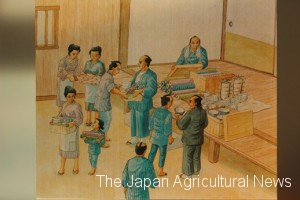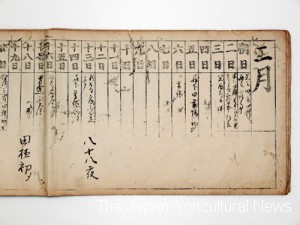Consideration for heavy work of agricultural work
Improvement of schedule making efficiency
Yugaku Ohara focused on planning and rationality of agricultural work. He guided farmers to make an annual agricultural calendar called “work assignment schedule (Shigotowari-hikae).” It remains in Endo family, the headman at that time.

Painting of Shigotowari (work assignment schedule) of March (top) and painting of the villagers to distribute the goods jointly purchased (collection of Yugaku Ohara Memorial, Asahi City, Chiba Prefecture)
The calendar indicated the labor force such as the size of arable land and the number of families, and estimated the annual labor amount for each work. For example, in the case of the March, it indicated “wheat harvest, 5 persons 1 day, 5 man-days labor”, and ” rice planting, 5persons 17 days, 85 man-days labor”. In addition, the annual calendar indicated the schedule from New Year’s Day to New Year’s Eve. The calendar also indicated Seigaku studies Dates (annual 48 days) and semi-holidays.
Seigaku farmers held “Evening consultation” meeting every evening after family members gathered. At the meeting, the family members consulted with the schedule and setup for preparation of next day’s work. The evening consultation meeting had the following effects;
1) It helped to make plan of tomorrow work clear so that family members could get down to work immediately after waking up in the morning. This eliminated the wasted time and promoted efficiency of work.
2) Each family member could work responsibly with awareness of each work allocated in convince mutual agreement.
3) Each family member could work knowing the main point of the crop cultivation and way of work.
In addition, he guided the principle, “to start work early in the morning, to complete main task until the noon, and to finish quickly in the evening.” Such principles were based on the thought that ” there is a need for consideration of farmers who have to work diligently and get tired heavily.” (Haruki Koshikawa, “Yugaku Ohara research”).
Such guidance was to bear fruit. Nagabe village (Asahi City, Chiba Prefecture) began to be able to pay nengu (tax) by deadline. The village received reward from the Shimizu family as an exemplary village.
When Nagabe village revival came out, new disciples increased further. In 1850, due to narrowness of Yugaku’ s house, he constructed instructor office called “Kaishinro (mind set tower)”. It was at the best period for both of Yugaku and the villagers.
◇
The next year, it turned dark. 5 gamblers broke into Kaishinro, asked to be disciple, and at last robbed money and goods. Officials had planned the crime by using gambler. He received the suspicion of Shogunate.
The objects were the fact that unidentified person gathered farmers and provided education, the fact of construction of Kaishinro beyond farmers means, the fact of formation of “Senzokabukumiai”, which was concerned with the taxable land without permission. After six years long-term trial, he became guilty, senzokabukumiai was disbanded, and Kaishinro was dismantled. The villagers burdened the expenses of his staying in Edo city during the trial and his disciples were also appeared in the service and supported him through internal jobs. Yugaku committed suicide in disappointment due to inconveniences to his disciples. His dream, creation of a “cooperative village”, was stopped.
◇
Nonetheless, after the death of Yugaku, the master, Mr. Endo, served as the teacher, and continued the little lecture on Seigaku. Old disciple revived senzokabukumiai in 1903 as the name of “Kyoyu-senzokabu (shared ancestor shares).” And they established “Yatsuishi Seirigakukai (Yatsuishi Chinese Natural Science Association) “, which was the first incorporated foundation of Chiba Prefecture, so as to execute honoring business and management of the facility. At the time of public corporation reform of April 2013, the foundation was disbanded, and now it has become a “Ohara Yugaku Denshokai (Ohara Yugaku lore association)”, as private organization.
Under the memorial hall, rice fields, which had been organized to arable land by Yugaku, is now managed by an organization that Asahi city etc. participated. Stakeholders of consumption cooperatives and children plant rice seedlings there and open the harvest festival in fall each year. Events of making “Seigaku mochi (rice cake)” using Non-glutinous rice are also planned in 2015.
◇
Seigaku
It stands for “Seirigaku (Chinese Natural Science)”. Neo-Confucianism was the academic study of China at the period of Song Dynasty. Its scriptures are ” Book of Great Learning,” ” Book of Doctrine of the Mean,” ” Book of Analects”, and “Book of Filial Piety.” It was affected by the Neo-Confucianism. It is said that “Seigaku” is the meaning of “removing desire from people and bringing them closer to “Tenri (Law of Nature)” (Kazuoki Ohno, “Hyakusho no gi (farmer ‘s righteousness)”). In the main work of Yugaku’s literature, “Bimiyugenko (Consideration of delicacy),” he emphasized that “considering morality aiming for the sustainability of family”.
◇
Next time is “Sontoku Ninomiya”.


